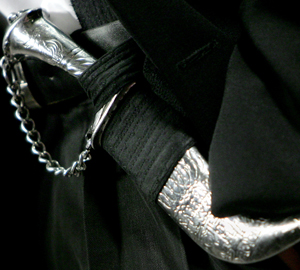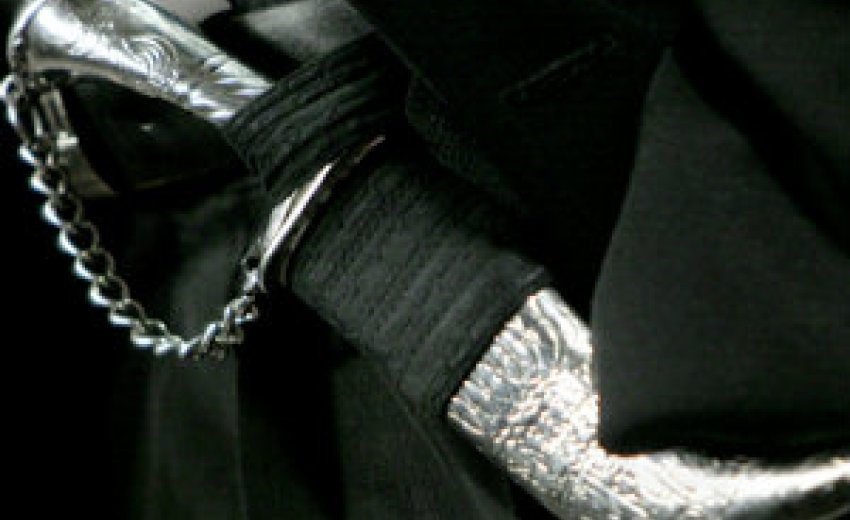
I could, I suppose, use the small crucifix at my neck to take out somebody's eye.
But, leaving aside its religious significance, a cross is primarily a decorative ornament, a piece of jewelery, and no more inherently dangerous than an earring post or hatpin – or a yarmulke or turban, for that matter.
With a great deal of imagination, one might posit that a yarmulke could be used – to what, choke a person to death by stuffing it into a victim's mouth? – and an unravelled turban wielded as ligature for strangling. Such arguments would be rightly dismissed as absurd.
Yet we live in an era of aggressive pre-emptive measures, when airline travellers can no longer bring bottled water on to a plane, or concertgoers carry umbrellas into a stadium.
The ingenuity of those with mayhem on the brain – shoe bombers, undies bombers, crazed alchemists mixing up explosive liquids from chicken soup and nitroglycerine – has compelled security agencies to restrict so much of what once seemed harmless, X-ray peering right into our entrails.
The kirpan, though, still gets a pass.
Why should it?
While the Sikh faith maintains that the kirpan is an instrument of ahimsa – meaning non-violence – and to be used only as a defensive weapon, by way of preventing harm from being done to oneself or another person, the thing is still essentially a knife, for all that Canada's top court has danced on a pin to rule otherwise in allowing it as a mandatory religious observance.
It now seems probable – witnesses have said so – that a kirpan was used to stab a prominent Brampton lawyer after he tried to disperse an angry mob that had gathered to protest the planned – subsequently cancelled – lecture by an excommunicated Sikh preacher at the Sikh Lehar Centre Friday night.
Manjit Mangat was taken to hospital with stab wounds to his abdomen, thighs and legs, plus cuts to his face.
Religious confrontations are often combustible. With daggers to hand, this one got bloody, fast.
Gun enthusiasts are always saying: Guns don't kill people, people kill people. Strictly speaking, that's true – a firearm is a benign object unless utilized for the purpose for which it was invented, which is, well, to shoot people.
That's why Canadians are prevented from owning or carrying sidearms except in limited circumstances, with strict requirements for storage and transport.
But we tread softly, in a legal context, when assessing the virtues and non-lethality of a kirpan, weighing constitutionally guaranteed religious rights against the public's right to security.
Back in the age of innocence, that might have made sense, though there has always been widespread controversy.
The Supreme Court of Canada, in its unanimous wisdom, ruled in the culmination of a long legal battle (Multani v. Commission scolaire Marguerite-Bourgeoys, 2006) that Quebec's highest court had erred in siding with a school board that tried to prevent a 12-year-old Sikh boy from wearing his kirpan to school.
Because the child's parents chose to pull the boy out of public school rather than take away his kirpan – doing so posed an "irreconcilable friction" with their tenets of faith – the Supremes concluded the child's religious rights had been compromised under the Charter.
The court ruled that the kirpan need not be addressed as a "weapon," allowing the boy's family to demonstrate merely a "personal, subjective belief in the religious significance of the kirpan," and accepted that prohibiting the youth from carrying it was more than a "trivial interference" of religious rights enshrined in the Charter.
To buttress their decision, the Supremes noted there had never been a known case of a kirpan being used violently in any school across Canada.
But there have been cases since.
Further, this isn't just about boys taking kirpans to school – the same schools where zero tolerance has prevented girls from bringing Midol to class in their purse.
Courts in many countries have been struggling with this issue. Denmark's High Court, as an example, has ruled that religion is not a valid reason for carrying a kirpan.
More often, compromises on size and proper sheathing – as in Canada – have been reached, as was the case during the Vancouver Olympics.
In Canada and the U.S., Sikhs are permitted to fly with their kirpans, but must turn them over to the aircraft's crew before boarding.
Yet just two years ago, Sikhs were dropped from an interfaith delegation scheduled to meet with the Pope because of their refusal to set the kirpan aside.
There is a historical context for the kirpan, its use arising from necessity centuries ago. Symbolism has now replaced necessity, and baptized male Sikhs must wear a kirpan, along with the turban.
It is not for me, a mostly non-practising Catholic, to lecture Sikhs about anachronisms in religious observance. All faiths have 'em.
But a dagger used to stab a man in Brampton – which is hardly the Punjab of 1708 – has made this, once again, a matter of communal, secular concern.
As an aside, it's interesting to note that Bill 94, proposed by Quebec Premier Jean Charest to ban face coverings for Muslim women in Quebec, with accommodation specifically denied for reasons of "security, communication or identification," does not outlaw the kirpan.
Surely a dagger worn by men is more of a security compromise than a piece of fabric over a woman's face?

